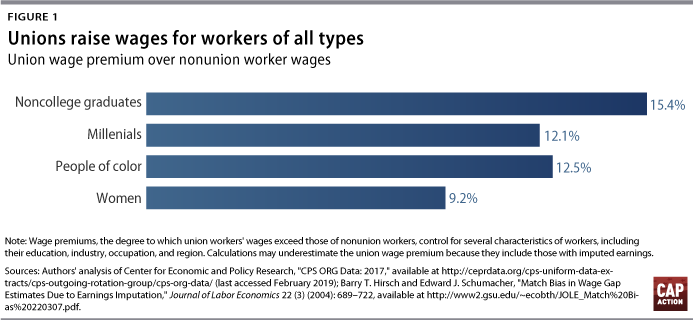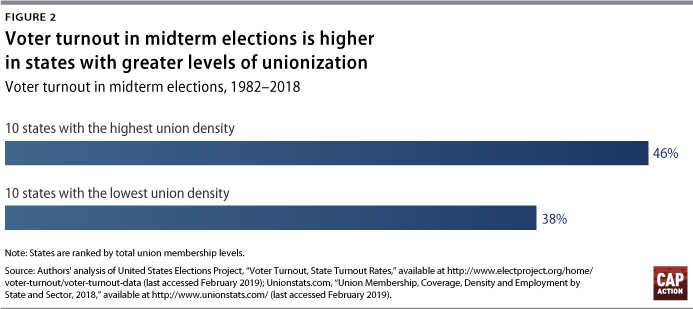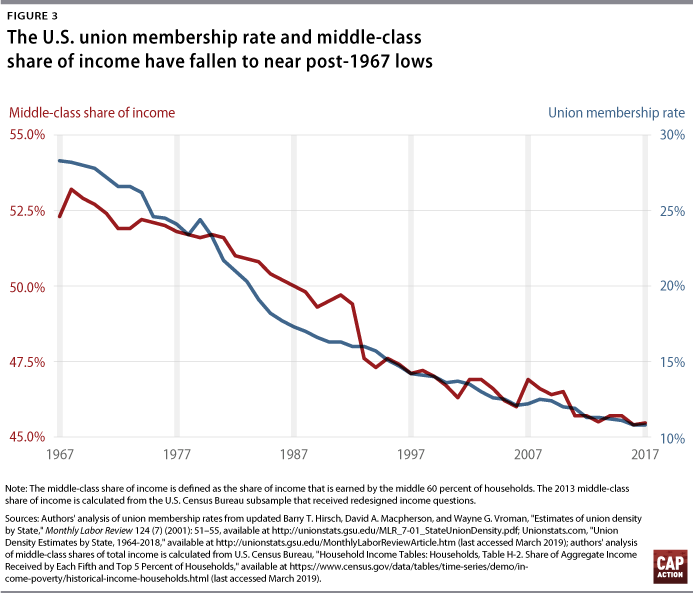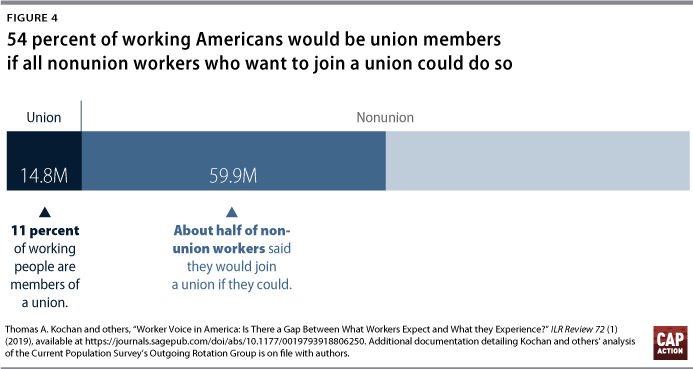Unions help ensure that working people earn decent pay and benefits and have a voice in our democracy. Unfortunately, decades of conservative and corporate attacks on unions, as well as a changing economy, have eroded the power of American unions. As a result, workers’ wages and well-being have declined, leading to a less equal society. Federal lawmakers must act to reverse this decadeslong trend of declining unionization rates.
Unions raise pay, improve benefits, and strengthen economic conditions
- Unions raise wages for all types of workers. When unionized workers are compared with similar nonunionized counterparts, analysis shows union wages are about 12 percent higher.1 The union wage premium is even larger for some demographic groups, including workers of color and those without a college degree.

- Workers in unions have the power to negotiate for high-quality benefits, such as health insurance, retirement, paid sick leave, and family leave.
Union employers, compared with similar nonunion employers:
- Contribute 56 percent more toward workers’ retirement
- Pay 77 percent more toward workers’ health care
- Provide 11 percent more toward paid vacation and holidays2
- Unions give children from low-income families a better chance of moving up the income ladder. Research shows that communities’ union membership levels and high school dropout rates are equally strong predictors of low-income children’s earnings as adults.3
Unions make democracy work for everyone
- Corporate interest groups and the wealthy play an outsized role in American politics, often shaping government policy to help themselves rather than the population at large. Unions are an important check on corporate power, leading efforts to raise state and local minimum wages, support the passage of the Affordable Care Act, and fight against President Donald Trump’s corporate tax cut bill.4
- Unions are one of the few types of advocacy groups whose positions align with the economic interests of working people. According to research by Princeton University’s Martin Gilens, unions lobby for policies that, more often than not, low- and middle-income Americans support.5 Corporate interest groups—including the National Restaurant Association, oil companies, and the U.S. Chamber of Commerce—advocate against policies that low- and middle-income Americans favor.
- Mobilization efforts led by unions help boost voter turnout. Union led get-out-the-vote efforts increase turnout, particularly among voters of color and working-class voters.6 Also, voter turnout is higher in states with higher unionization rates.

Conservative lawmakers and the courts have tilted the law against workers
- So-called “right-to-work” laws and the U.S. Supreme Court’s recent decision in Janus v. AFSCME have undermined unions by allowing workers to receive the benefits of unionization without having to pay for its costs.7 In the case of state right-to-work laws, union membership rates have fallen as a consequence. As a result, unions have less power to bargain for decent wages and benefits for all members.
1 in 3: The portion of union elections where corporations fire at least one pro-union worker8
- Companies that break the rules face few repercussions. Corporations can stamp out unionization efforts through legal means—such as forcing workers to attend mandatory anti-union meetings with their supervisor—and through illegal means, such as firing workers for supporting a union.
American labor law has not kept up with recent changes in the economy
- Workers typically must negotiate work site by work site instead of with groups of companies or across an industry. This has become less effective in recent years, as companies contract out work and directly employ fewer people.9
- As firms’ structures change, workers often have trouble negotiating with the firm that is in charge. Moreover, they risk receiving lower pay and losing benefits when their employer changes, since labor suppliers are under pressure from contracting companies to keep costs low. As the percentage of workers in unions declines, enterprise-level bargaining leaves out a growing share of the workforce. Enterprise-level bargaining also increases conflict between workers and their companies, since unionized firms may have higher labor costs than their competitors.
- Workers’ free speech rights are constrained by laws that restrict their right to strike to improve pay and conditions—especially when they are dealing with outsourced work, since workers may only strike against their direct employer.
As a result of weakened unions, middle-class Americans are doing worse
- After states enact right-to-work laws, workers are less likely to be contacted to vote; turnout falls, and fewer working-class candidates serve in government.10
- Working Americans take home smaller paychecks due to the decline in unions. According to the Economic Policy Institute, nonunion workers have lost roughly $133 billion in annual wages due to weakened unions.11
- Unions help increase the share of income going to the middle class and constrain top-end incomes. The decline of unions explains one-third of the growth in inequality among men and one-fifth of the inequality among women from 1973 to 2007.12
- As union membership declines, so does the prosperity of the middle class.13


3 essential changes Congress must enact to strengthen collective bargaining
The United States needs a collective bargaining system that not only fixes holes in existing law, but also adapts to the changing economy.14
1. All workers should be free to join a union and bargain
- Workers who are excluded from federal labor laws—including public sector workers, low-level supervisors, and most independent contractors—should have the right to join a union.
- All workers should be protected against employer retaliation. Corporations should face significant fines for violations of labor law—including illegal firings—and should be required to temporarily reinstate fired workers while the National Labor Relations Board (NLRB) investigates. Workers should have the ability to go to court or work with the NLRB to redress violations.
- Workers should not be forced to attend anti-union meetings; have their ability to communicate with each other limited by their employer; or be required to sign agreements to arbitrate workplace disputes individually.
2. Workers need more power to make collective bargaining work in the modern economy
- Workers should be able to bargain with corporations that have the power to improve working conditions, in addition to their direct employer, and decide if bargaining should include multiple firms.
- When a majority of workers demonstrate their support for a union, corporations should be required to bargain with them and, if bargaining becomes protracted, submit to arbitration for a first contract.
- Workers should have the right to strike, picket, or boycott their own employers or other employers without fear of being punished.
- The government should promote bargaining across industries through wage boards, as is done in some cities and states. In heavily unionized sectors, wage boards would extend the labor standards set in collective bargaining agreements to nonunion workplaces. In nonunion sectors, wage boards would allow far more workers to push for better work conditions by bringing together workers, employers, and the government to set minimum workplace standards.
- Large corporations should be required to further strengthen workplace democracy by adopting works councils and including workers on their boards.
3. Government should be on the side of strong unions and worker organizations
- The government should ban state right-to-work laws; allow all workers to deduct a portion of their pay to unions or other worker organizations; and ensure that unions are able to maintain contact with workers through modern and convenient means.
- Policymakers can incentivize membership by ensuring that unions have a key role in providing public benefits—including workforce training—and the enforcement of workplace laws.
- The government can raise standards for private sector workers whose jobs are funded by the federal government—including federal contracts, loans, and grants. Federal funding recipients should pay wages that do not undercut collectively bargained wage rates and refrain from any activity that would interfere with workers’ right to organize.
- In its role as an employer, the government can ensure that unionized workers are able to communicate with existing members and train new hires on the benefits of membership.
Karla Walter is the director of the American Worker Project at the Center for American Progress Action Fund. David Madland is a senior fellow at the Center.
Endnotes